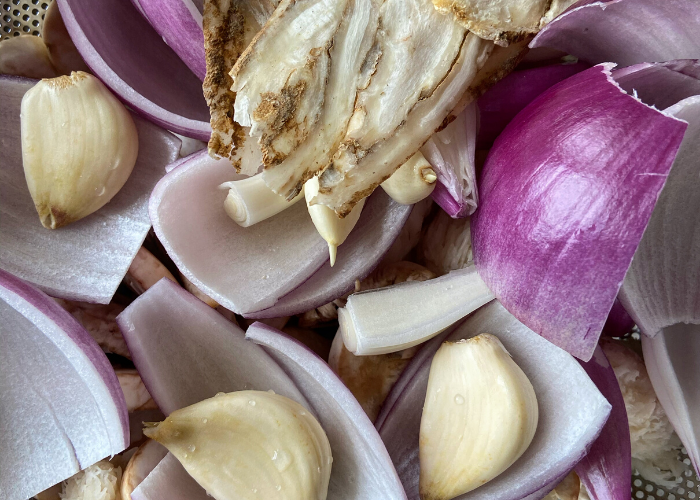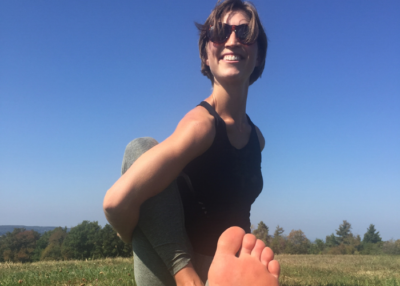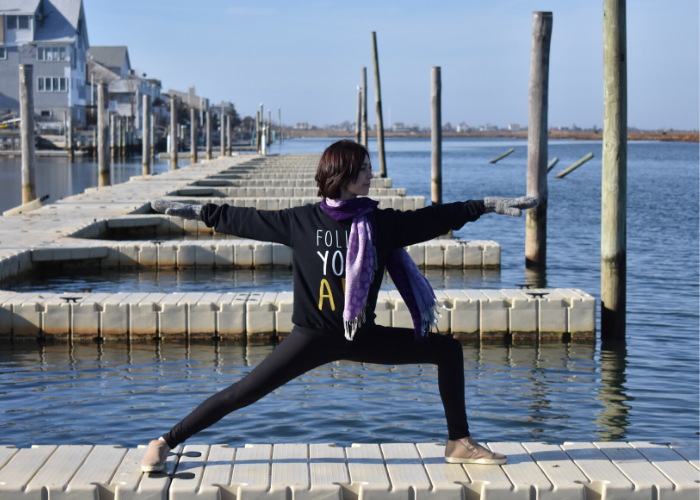What does yoga and Chinese herbal medicine have in common?
They both embody a desire for change and for balance. The purpose of yoga is that we move and distort our bodies so that we can withstand to sit with ourselves in stillness.
The purpose of Chinese herbal medicine is to regulate that which has become dysregulated. It’s to create space & balance so that we can exist in harmony in our bodies.Both are a tool to rectify the consequences of being human, which we all suffer from! 🙃The triangle is a potent symbol for the Divine Principle & the three sides of the triangle represent the forces of the universe: Brahma the creative force, Vishnu the sustaining force & Shiva, the force of change.Kara GoodsellAll gunas create attachment and thus bind one’s self to the ego. “When one rises above the three gunas that originate in the body; one is freed from birth, old age, disease, and death; and attains enlightenment,” (Bhagavad Gita 14.20).While the yogis goal is to cultivate sattva, his/her ultimate goal is to transcend their misidentification of the self with the gunas and to be unattached to both the good and the bad, the positive and negative qualities of all life.Timothy Burgin
The triangle pose represents a strong mental and physical foundation formed by the two bottom points of the triangle. From here, you can begin to look up to explore the third point, the spiritual. (Shaw, 83).I relate this back to a formula in Chinese medicine called gan mai da zao tang/Licorice, Wheat & Jujube Decoction, because it works in a similar way, and also treats the the presentation of the yogi who is unable to find balance and strength in the footing of trikonasana.The ethereal and corporeal souls come and go with the spirit and essence. In order to guide the drifting souls back toward a more normal attachment to the body, the formula (gan mai da zao tang) focuses on tonifying the nutritive qi with sweet substances while simultaneously inhibiting the unrestrained dispersal of souls.The formula is appropriate for patterns of what is referred to as restless organ disorder/zang zao, “an emotional condition that is generally due to excessive worry, anxiety, or pensiveness. This injures the Heart spirit and unsettles the ethereal and corporeal souls,” (Barolet, Bensky, Ellis, Scheid, 471).Somebody who fits this pattern may present with symptoms such as “disorientation, frequent attacks of melancholy and crying, restless sleep, inability to control oneself, & frequent bouts of yawning. Not only is the cause of this disorder primarily emotional, it’s manifestations are also of an emotional nature. This is due to the ethereal and corporeal souls losing their mooring and the spirit being lost. An easy to conceptualize example of this is somebody suffering from depression. They may feel that they are missing their sense of purpose in the world or are lacking a connection to reality.Gan Mai Da Zao Tang/ Licorice, Wheat & Jujube DecoctionXiao mai-chief, sweet salty, lightweight, reaching outward nature. Enters heart, conserves fluid of the heart. Controls dispersal of ethereal and corporeal souls.Gan cao-deputy, nourish heart, tonify qi, harmonize middleDa zao-deputy-sweet, augments qi and moistens internal drynessDrains excess “governs pathogenic qi in the heart and abdomen, quiets the middle, nourishes spleen, and assist the twelve channels.By combining three simple and everyday herbs, gan mai da zao tang “Nourishes the Heart, calms the spirit, harmonizes the middle burner, & relaxes hypertonicity,” (Barolet, Bensky, Ellis, Scheid, 471).Let’s break down each herb and corresponding angle or aspect of triangle pose.Gan Mai Da Zao Tang/ Licorice, Wheat & Jujube DecoctionGan cao (licorice root/Glycyrrhizae Radix) → Vishnu the sustaining force Xiao mai (wheat/Tritici Fructus) → Shiva the force of changeDa zao (Jujube fruit/Jujubae Fructus) → Brahma the creative force Da zao represents Brahma, the creative force. It is sweet, warm and enters the Spleen and Stomach. Da zao tonifies both the qi and the blood, generates fluids, restores harmony to the nutritive and protective qi, and moderate the toxic effects of relatively harsh herbs. By harmonizing the earth & unblocking the twelve channels, there leaves space for clarity. When the spleen & stomach (the earth) are not functioning properly, one may feel spacey or that they cannot think clearly. “When the normal qi is sufficient, the spirit is quiet,” (Seeking Accuracy in the Materia Medica). When the spirit is quiet, the nature of the creative force can be true. It’s sweet so that it tonifies the middle, and warm so that it augments the qi. When the spleen and stomach are tonified, the twelve channels are unblocked naturally, the nine orifices are facilitated, and the four extremities are harmonized.
In trikonasana the chest is broad, the heart is expansive. Da zao represents the nourishing of the heart through openness & the reaching towards the sky reflects the imaginative nature of Brahma. When there is balanced footing on the earth, the gaze can lift upwards into the realm of infinite possibilities without the physical body losing its baring.
Gan cao represents Vishnu, the sustaining force. With it’s sweet, neutral & moderating nature, licorice root is used in many formulas to harmonize all of the other herbs. In gan mai da zao tang, it also carries out its function to drain excess. It “tonifies the spleen & augments the qi,” (Bensky, Clavey, Stoger, 737). It symbolizes the footing on the ground in triangle pose. One must have the ability to balance and evenly distribute their weight between both legs, finding strength through the base. The front leg generates stability & power while the back leg generates length of roots that drive deep into the earth. The touch point between of the pinky toe side of the foot & the ground connects the yang aspect of the body to the earth, spreading up the leg, the side body, & connecting with it’s yin counterpart through the softness of the inner arm & the outreach through the palm and fingertips.
The two points of the triangle meaning the soles of each foot. Only when the yogi is grounded and balanced in their alignment, can they begin to focus on the actions of the upper body and the drishti (visual focal point). Without the physical foundation, the sustaining force, if one were to try to bring their gaze upwards toward the ceiling or sky, they may lose their balance. The modification for this would to be to keep the gaze down at the foot or towards the side wall.
Xiao mai represents Shiva, the force of change. Xiao mai is sweet, salty and light. The herb is light in nature so it’s action in the formula is to “disperse the ethereal and corporeal souls,” to guide them back home.
There are multiple triangles in Trikonasana. Gan cao and da zao represent the forces of Brahma and Vishnu through the three triangles formed by the legs and arms. While Xiao mai represents a more innate geometrical wisdom through the shape, of the lungs, the pelvis and the pelvic floor. All imperative components of the breath. Xiao mai is the chief of the formula. It “is light in weight, reaching outward to the exterior, yet also enters the Heart channel where is conserves the fluids of the Heart,” (Barolet, Bensky, Ellis, Scheid, 471). Similar to the breath, it has a connection to the outside of the body and a direct relationship with the form and function of the heart. Our breath is our connection to spirit and “is at the center of our existence,” (Keown, 167).
“The lungs are seen as making this connection between body and spirit because they are not only the highest organs in the body but also they deal with the most rarified of substances – air,” (Keown, 167). When we engage in proper breathing in yoga, or in any moment, several pieces of the body are at play. Though leaders in breath are the pelvic floor, lungs and diaphragm. When these structures are engaged with properly, the tissue is happily nourished. Seen in these diagrams are the imperfect triangles that exist within these natural structures.
When we lose our relationship with our breath, we lose the connection with not just the spirit but with control and engagement, making it easy for dis-ease to arise. This erratic breathing could easily be the root &/or branch of this restless organ syndrome that we are addressing. Herbal medicine aside, breath work alone could bring the patient or yogi back to ease.
Though in this context Xiao mai represents Shiva, the force of change, the breath is the true force of change. It was said by the ancient sages, “One who knows the science of breath knows everything,” (Rama, 58). The goal of Gan mai da zao tang is to guide the spirits back to their home. This action can also be achieved through proper breath and alignment in triangle pose.
Triangle is one of those yoga poses that at first may seem sort of basic or fundamental. Though when looked at a bit closer, or practiced with deeper intention, it is actually quite complex and sophisticated. It requires a multitude of subtle alignments to draw out the true benefits. When the yogi is practicing triangle pose and they hit that sweet spot of alignment, it may feel like they are solving a puzzle, or fitting the right key into a lock. It’s relatively simple to achieve the posture from an aesthetic perspective, but takes time & modifications execute it to it’s full potential. Through just a subtle adjustment of the pelvis or the angle of footing etc., the entire pose can transform. And when it does make that transformation, the body unlocks it’s true strength through the magic of the triangle. When the body takes on this shape, it takes on it’s ability to take the weight of the world and evenly distribute it between its three sides (vishnu, brahma, shiva). It becomes a force.
By combining three simple and readily available herbs, this formula achieves a remarkable effect; it guides the floating souls back within the bounds of normal behavior, allowing the patient to feel at ease with themselves again. If the efficacy of such “kitchen medicine” may be difficult to accept because only powerful remedies are considered capable of treating unusual disorders, physicians through the ages have been aware that it is precisely this simplicity that generates the effect.
What could be more subtle than pacifying the wayward soul by means of herbs that nourish the nutritive yin, governed by the Heart & therefore rooting the spirit? (Barolet, Bensky, Ellis, Scheid, 471).
What we have here is two separate modalities with similar intentions, to have footing on the earth, peace and steady breath within, a connection to the spirit and to feel at home within our bodies in a world filled with external chaos.
If you are interested in Chinese herbal medicine, visit me at Aliyah Health in Syracuse, NY. 😊
*Disclaimer – This post is not intended to be a substitute for professional medical advice, diagnosis or treatment. Always seek the advice of your qualified health care provider with any questions you may have regarding a medical condition or treatment and/or before undertaking a new health care regimen. Please never disregard professional medical advice or delay in seeking it because of something you have read on this website. Please do not attempt advanced yoga poses without the guidance of an experienced instructor. Please do not take Chinese herbal medicine without the guidance of an experienced herbalist.
Works Cited
Bensky, D., Clavey, S., Stoger, E. Chinese Herbal Medicine: Materia Medica. Eastland Press Inc., 2004.
Flaws, Bob. Statements of Fact in Chinese Medicine. Blue Poppy Press, 2004.
Barolet, R., Bensky D., Ellis, A., and Scheid, V. Chinese Herbal Medicine: Formulas & Strategies. Eastland Press, 2015.
Lecture. Lennessa Shantaya. Kaivalya Yoga Academy. 2016.
Swami Rama. The Royal Path. 2014.
Keown, Daniel. The Spark in the Machine. Singing Dragon, 2014.




